Six thrush species can be seen in the UK, with four resident all year round, and an additional two visiting in winter and occasionally remaining throughout the year.
Although you may instantly associate thrushes with birds with speckled breasts, this is not the case for every thrush family member spotted on UK shores.
All the British finches mentioned below can be observed in the UK. However, whilst some are widespread, others are only seen in particular, localised areas and aren't present throughout the entire country.
Blackbird
Turdus merula
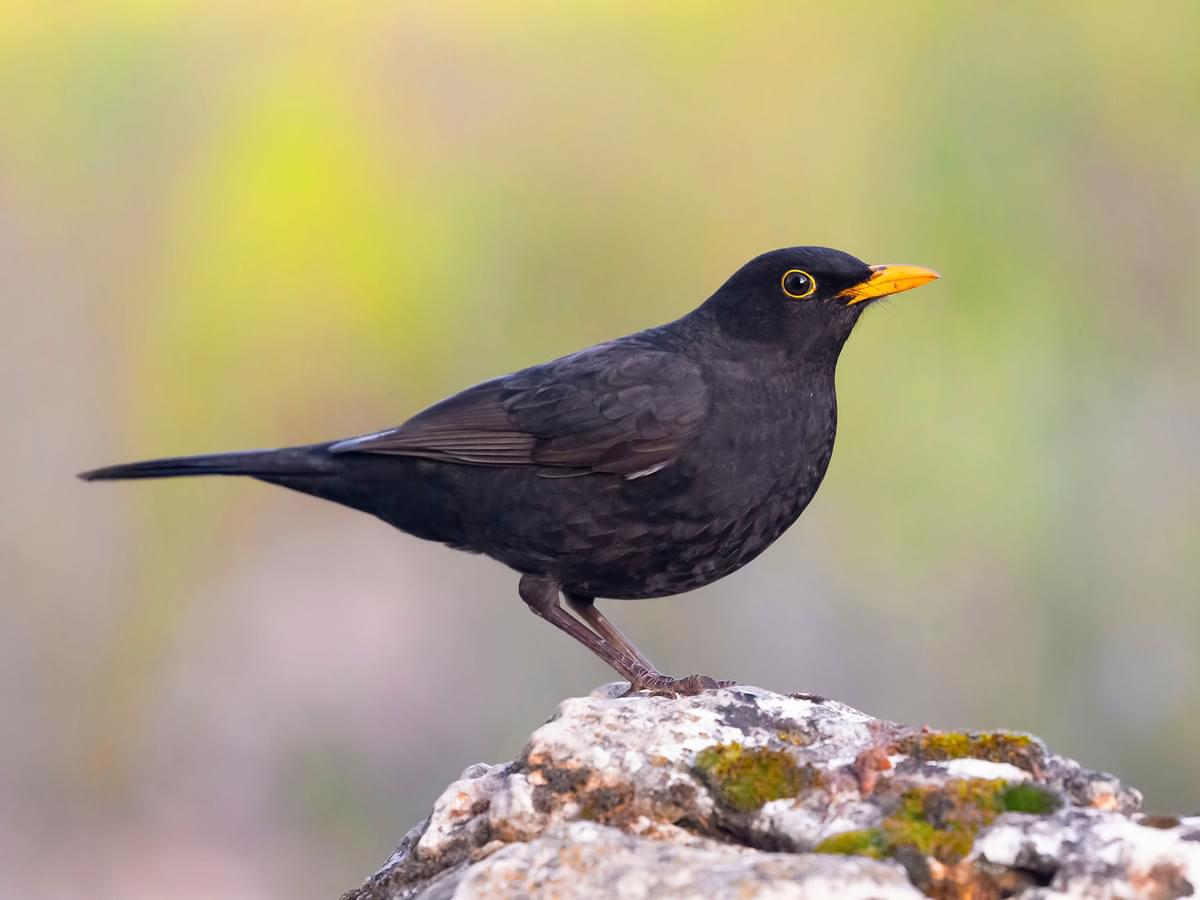
Length
23-29cm
Wingspan
34-38.5cm
Weight
80-125g
Blackbird
The most common and widespread member of the thrush family, blackbirds (Turdus merula) are present all year round.
More than 5 million pairs of blackbirds breed in the UK every year, and these numbers are swelled further each autumn by visiting birds from northern Europe, where harsh conditions make it particularly challenging to find food in winter.
While male blackbirds are black, females are actually a dusky red-brown and have a more speckled appearance, particularly on the breast.
Males have bright yellow eye-rings and beaks, while females’ beaks and eye rings are a more muted shade of yellow. Juvenile blackbirds are also speckled, reddish-brown, with lighter patches of feathers around their throat.
Fieldfare
Turdus pilaris
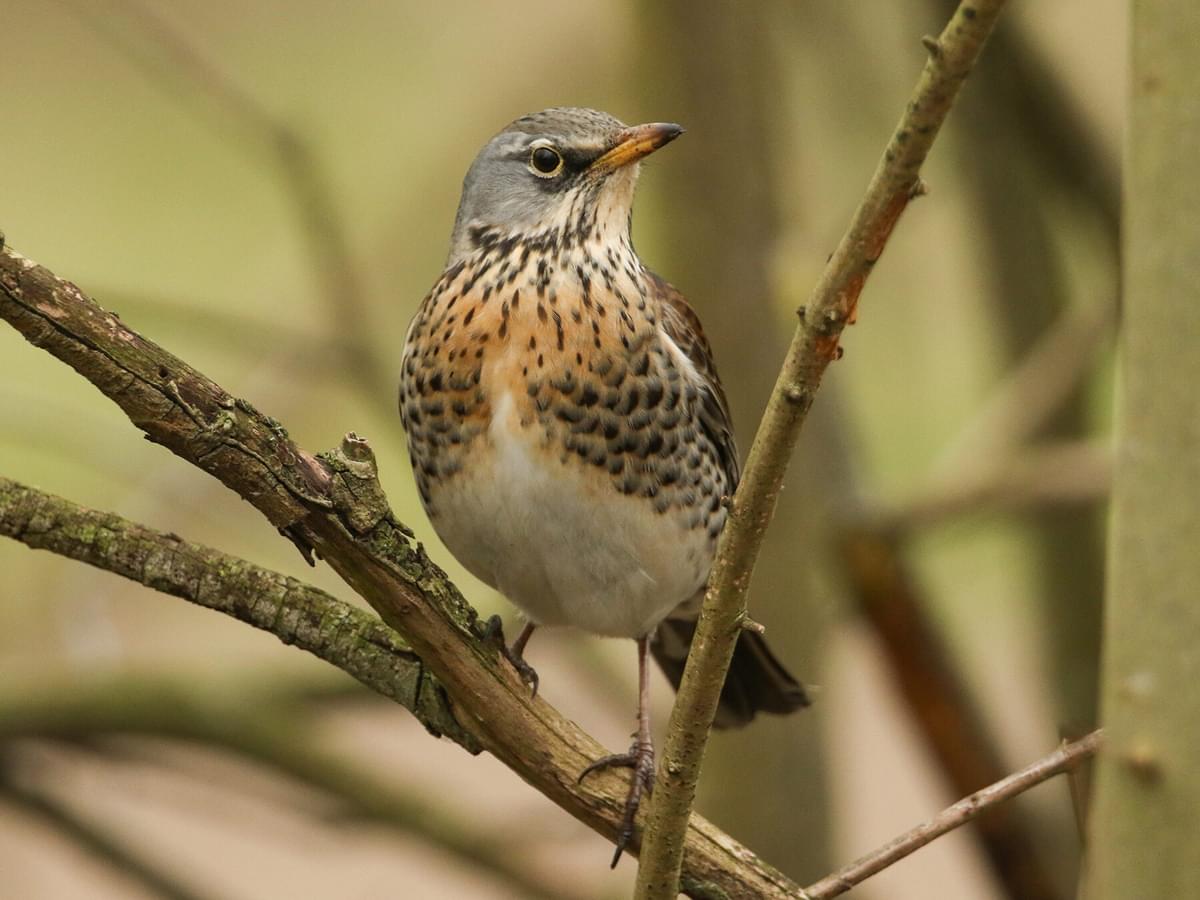
Length
22-27cm
Wingspan
39-42cm
Weight
80-130g
Fieldfare
Fieldfares (Turdus pilaris) are slightly larger than blackbirds, but the two thrushes are nothing alike in appearance.
Fieldfares have slate-grey heads, napes and rumps, dark brown backs and black tails. Their throats are tinged with orange, and their breast is a paler shade of buff - both are speckled with dark brown markings.
Around 680,000 fieldfares descend on the British countryside each winter, to take advantage of milder temperatures and abundance of wild berries, particularly hawthorn, yew and juniper. Only a handful of breeding pairs remain in the UK all year round.
Mistle Thrush
Turdus viscivorus

Length
26-29cm
Wingspan
45-50cm
Weight
93-167g
Mistle Thrush
The largest, heaviest member of the thrush family, the mistle thrush (Turdus viscivorus) is widespread throughout the British Isles all year round.
Significantly less common than song thrushes, there are around 170,000 mistle thrush territories in the UK, with woodland, hedgerows, parks and gardens their preferred habitat.
The mistle thrush’s scientific name, Turdus viscivorus, comes from its fondness for mistletoe berries, with viscum meaning "mistletoe" and vorare meaning "to devour".
Other berries are also eaten, including yew, holly and hawthorn, as well as fallen fruits. Mistle thrushes also use an ‘anvil’ technique to smash snails’ shells on stones to eat the insides.
From a distance, mistle thrushes are similar in appearance, but side by side are easy to tell apart. Mistle thrushes are larger and paler than song thrushes. The spots on their chest are black rather than brown, and they are generally more aggressive and territorial than other thrushes.
Song Thrush
Turdus philomelos
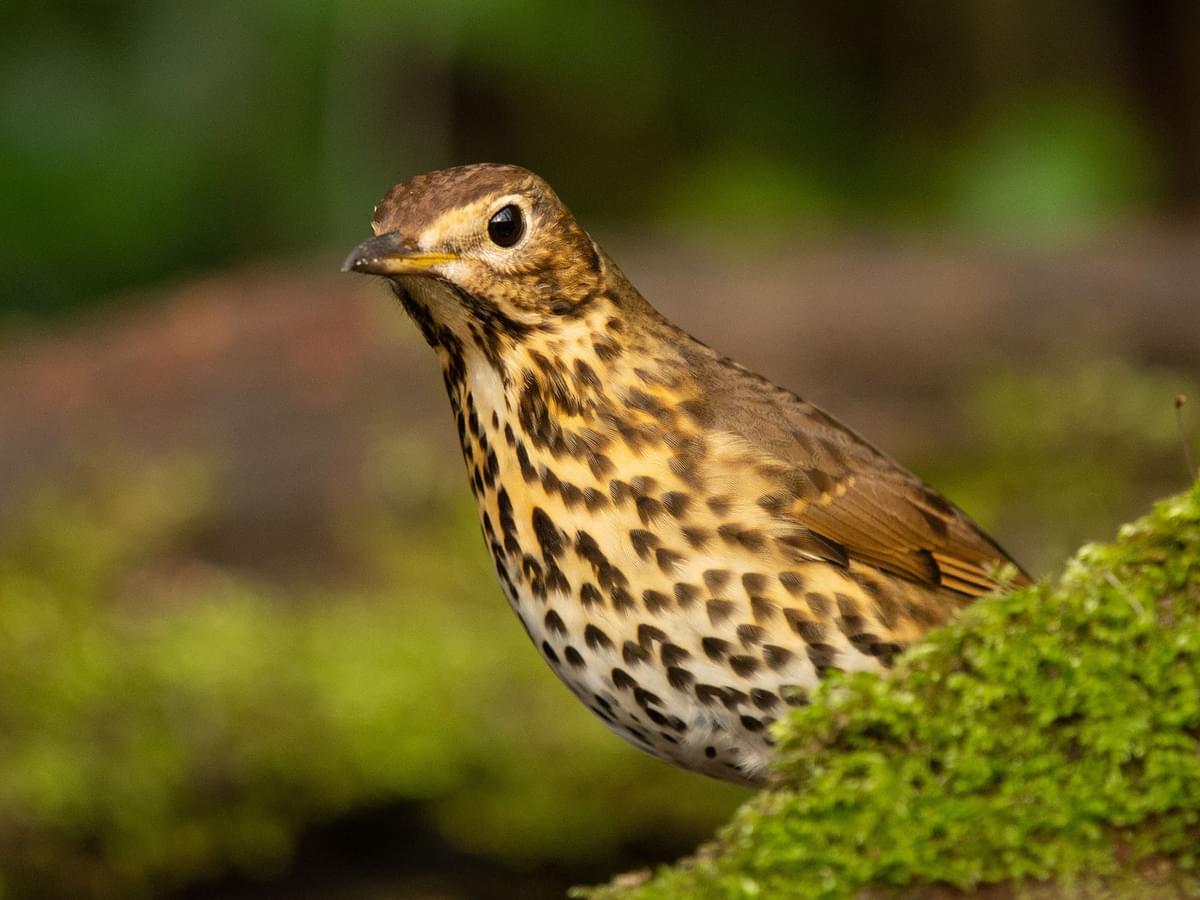
Length
20-23cm
Wingspan
33-36cm
Weight
65-100g
Song Thrush
The song thrush (Turdus philomelos) is perhaps the most iconic family member, with its pale breast speckled with dark brown, and its rich brown wings and back plumage.
Males and females are identical in appearance, but one way that the sexes can be distinguished is by listening out for their song.
Male song thrushes are particularly well known for their vocal talents, belting out repetitive melodies that copy other birds’ songs from high branches of trees, particularly at dusk.
Earthworms and snails form the largest share of a song thrush’s diet, with hedgerow berries being important in autumn.
Song thrushes are found in parks, gardens, hedgerows, and coniferous and deciduous woodlands, although numbers have declined steeply since the 1970s due to loss of habitat, especially in agricultural areas.
Redwing
Turdus iliacus
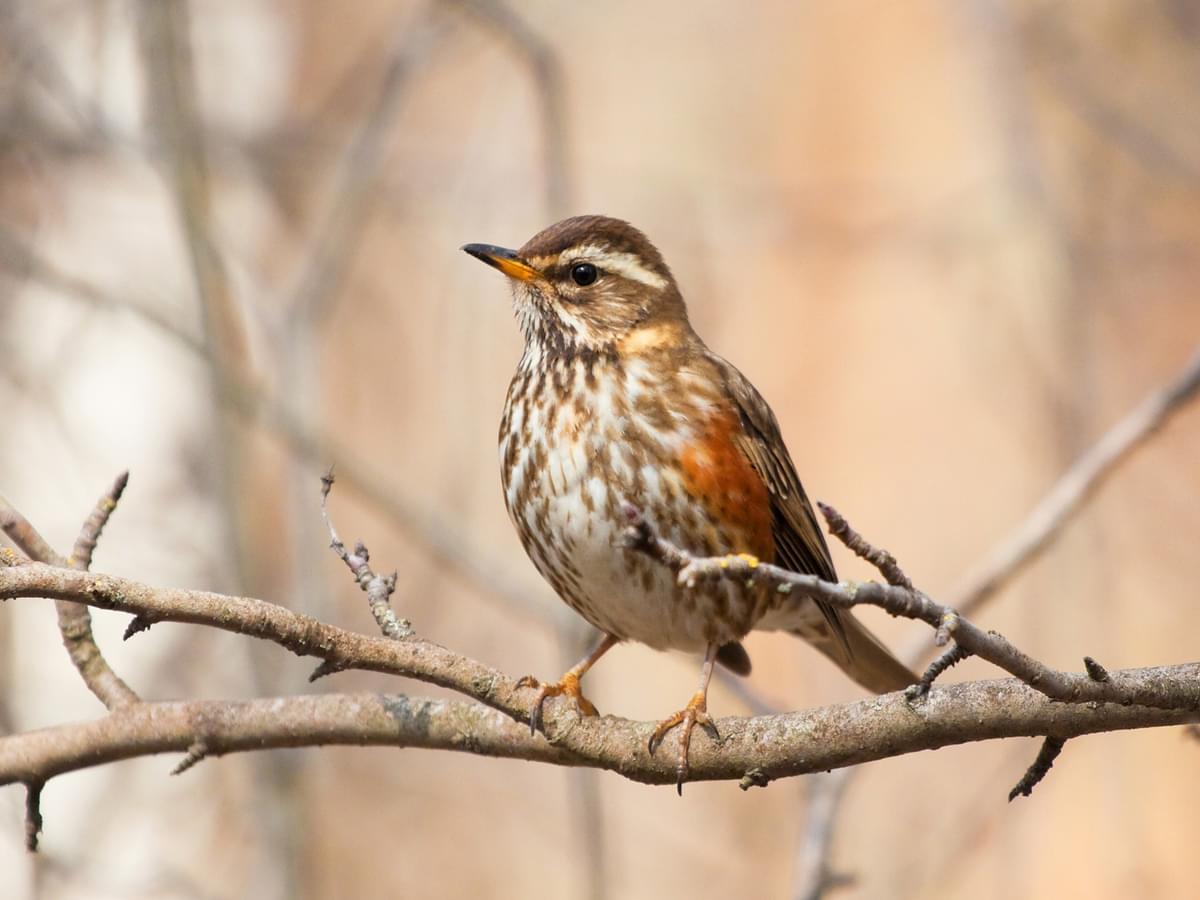
Length
20-24cm
Wingspan
33-35cm
Weight
50-75g
Redwing
The smallest member of the thrush family to regularly visit the UK, redwings (Turdus iliacus) are common winter visitors, arriving from Iceland and Scandinavia each autumn from late September onwards.
Around 8.6 million redwings spend the winter in the UK, and can frequently be seen in open countryside, hedgerows and even back gardens throughout the country, foraging for berries.
Redwings are similar in appearance to song thrushes, although can be distinguished by the fiery orange-red patch on their flank under each wing, and the creamy-white stripe next to their eyes.
Ring Ouzel
Turdus torquatus
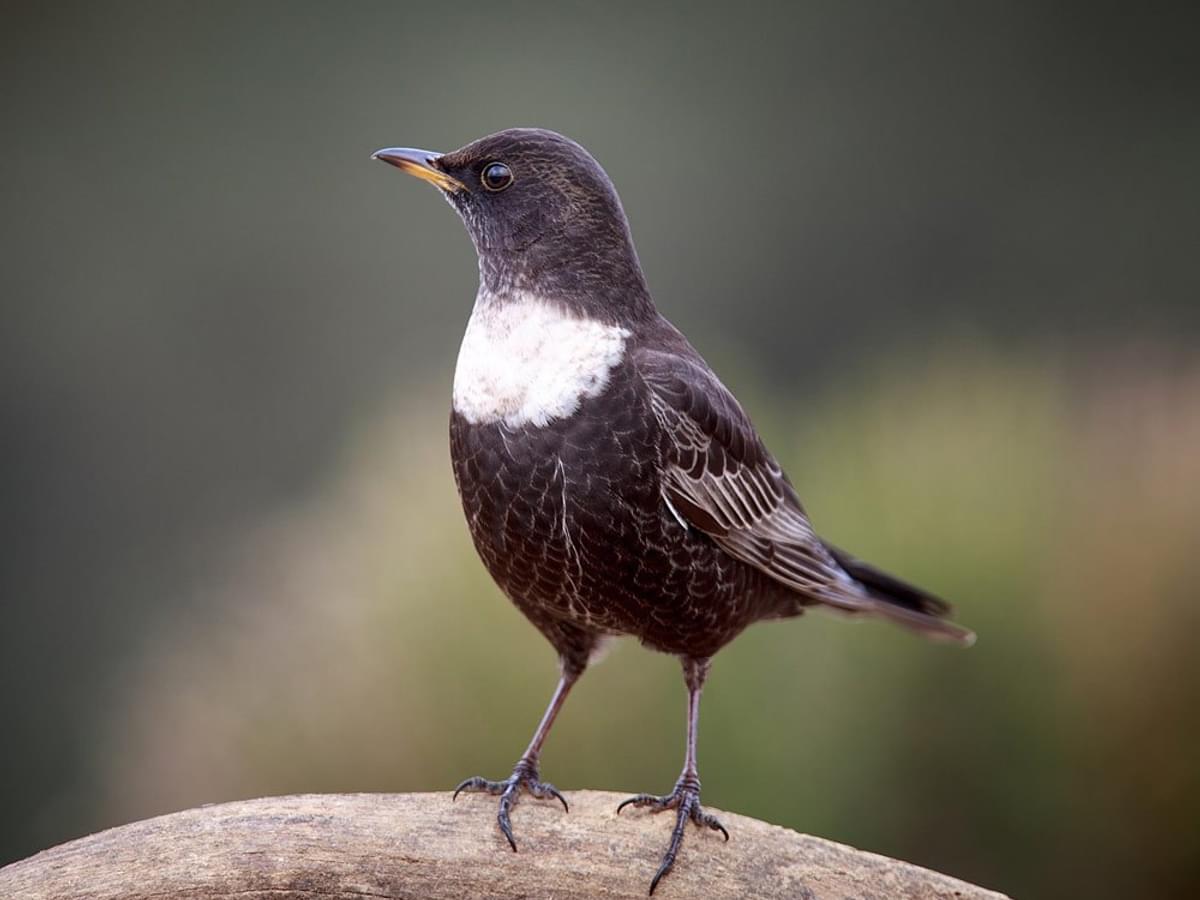
Length
23-24cm
Wingspan
38-42cm
Weight
90-138g
Ring Ouzel
The rarest of the UK’s thrush family members with just over 6,000 breeding pairs, ring ouzels (Turdus torquatus) breed in rocky uplands in Scotland, on Dartmoor, in north-west Wales and across northern England, before heading south to spend winters in Spain and north-west Africa.
During their annual spring and autumn migrations, it is not uncommon to spot ring ouzels on grasslands around the eastern and southern coasts of England.
Similar in appearance and size to blackbirds, ring ouzels have a distinctive white ‘bib’ on their throat, and pale wing bars. The female’s colouring is a lot less striking and more ‘washed out’ than that of the male.
Ring ouzels live on heathlands, moors, and mountainous terrain, nesting in shrubbery and rocky crevices. Their diet consists mainly of worms, beetles, and berries.
What are thrushes?
Thrushes are classed as medium songbirds, with an omnivorous diet that largely consists of insects, invertebrates and berries. One feature shared by many thrush species is a distinctly speckled breast, as seen in the mistle thrush, song thrush, redwing, fieldfare, and female blackbird.
Thrushes are typically very vocal birds, with blackbirds and song thrushes being noted for their tuneful song repertoire, as well as their aggressive rising calls when defending a territory. Mistle thrushes will also noisily defend a nest site or a favourite fruit or berry tree.
Most thrushes are ground feeders, foraging for snails, earthworms and fallen fruit, as well as being especially partial to hedgerow berries.
Nests built by thrushes are cup-shaped, shaped with mud and lined with leaves and grass. They are constructed on branches of trees or within a dense shrub.

Close up of a perched Mistle Thrush
Where are the best places to see thrushes in the UK?
Blackbirds and song thrushes can be seen throughout the UK, in parks, back gardens, and woodlands and countryside hedgerows.
Mistle thrushes can be seen in rural settings and woodlands across the country. The species is present everywhere except the northern and western isles of Scotland, and extremely exposed mountainous uplands in the Scottish Highlands.
Ring ouzels are limited to rocky landscapes in mountainous regions of Scotland, and breeding pairs can also be seen on upland plateaus across northern England, in north west Wales and on Dartmoor.
Passage birds can be seen along the east and south coasts of England in spring and autumn.
Fieldfares and redwings arrive in the UK from October onwards and are widespread during winter months. The best chance of spotting one of these two visiting thrushes is in the countryside, such as orchards or cultivated fields with berry-laden hedgerow boundaries.
Only the highest, most barren areas of the Scottish Highlands do not offer suitable wintering grounds for fieldfares and redwings.

Fieldfares spend their winters in the UK, and can usually be seen from October
What is the most common thrush in the UK?
Blackbirds are the most common thrushes in the UK, and are widespread throughout the country and resident all year round.
Blackbirds are commonly seen in back gardens and parks, as well as in the wider countryside, woodlands and hedgerows, and are one of the country’s most familiar and recognisable birds.
Classed as a species of least concern, according to 2016 data, there were more than 5.1 million pairs of blackbirds in the UK. But the status of blackbirds as the country’s top-ranking thrush hasn’t always been the case.
In the early 20th century, song thrushes were significantly more numerous than blackbirds. Song thrushes now rank as the nation’s second-most common thrush, with 1.2 million pairs, although numbers have declined dramatically since the 1970s.

The blackbird is the most common thrush in the UK
What is the largest thrush in the UK?
Mistle thrushes are the largest thrush species seen in the UK, measuring between 27 and 28 cm (10.6 to 11 in) and weighing from 93 to 167 g (3.3 to 5.9 oz).
Fieldfares are a close second, with a length of up to 24 to 28 cm (9.4 to 11 in) and weight of between 81 and 141 g (2.9 and 5 oz).
Blackbirds are marginally smaller than fieldfares, around 24 to 27 cm (9.4 to 10.6 in) in length and weigh in the range of 85 to 105 g (3 to 3.7 oz).

The largest thrush in the UK, the Mistle Thrush
What is the smallest thrush in the UK?
The redwing is the smallest thrush to regularly be seen in the UK, visiting to spend winters here to avoid the extremely cold temperatures of its native northern Europe each year. Redwings measure from 20 to 24 cm (7.9 to 9.4 in) and weigh 46 to 80 g (1.6 to 2.8 oz).
Song thrushes are our smallest resident thrush, measuring 20 to 23 cm (7.9 to 9 in ) in length, and weighing between 50 and 107 g (oz).
Ring ouzels rank as the third smallest UK thrush species, with a length of 23 to 24 cm (9 to 9.4 in) and average mass of between 90 and 138 g (3.1 and 4.9 oz).

The smallest thrush in the UK, the Redwing
How many types of thrushes are there in the UK?
Depending on the time of year, up to six different thrush species can commonly be spotted on UK land. Four species are resident all year round, and in winter, these are joined by two additional temporary migrants, who come to take advantage of our milder winters (compared to temperatures in their native northern Scandinavian and Icelandic habitats).
On rare occasions vagrant species are spotted in passage, including the black-throated thrush, native to Asia and spotted in Grimsby in eastern England in 2020. In 2021, a White’s thrush, thought to have originated in Russia, was found dead in Dorset having flown into a glass window.

Close up of a Ring Ouzel
What thrushes are native to the UK?
Four species of thrush are native to the UK and breed here in significant numbers. These are blackbirds, song thrushes, mistle thrushes and ring ouzels.
At the end of the breeding season, UK ring ouzels migrate south in autumn to spend winter in southern Spain or the countries along Africa’s Mediterranean coast before returning to the Scottish Highlands each spring.
Fieldfares and redwings are winter visitors, arriving from Scandinavia and other chilly northern European locations during the coldest months of the year.
Breeding populations for these migrant species are present but numbers are incredibly low and cannot yet be classed as native species.

Song Thrush in full song whilst on the ground
Are thrushes protected in the UK?
All of the UK’s resident and migrant thrushes are protected under the Wildlife and Countryside Act 1981. Some thrush species have been granted additional levels of protection under either the IUCN Red List or the UK Bids of Conservation Concern list.
Mistle thrushes are widespread across Europe, but in the UK, numbers have declined significantly since the 1970s to warrant inclusion as a Red List species on the UK Birds of Conservation Concern survey.
Fieldfares were designated a UK Birds of Conservation Concern Red List species by the RSPB in January 2013, due to the low number of breeding pairs and population considered as being in critical decline.
Ring ouzels were inscribed on the UK Red List when the first list was drawn up in 1999, and is listed as the top level of conservation concern in England, Scotland, Wales and Northern Ireland. By 2012, the UK population of ring ouzels has declined by around 23 percent since a previous survey, recorded in 1999.
Redwings are classified as a near threatened species by the IUCN, as their global population has met the threshold of declining more than 30 percent over a ten-year period. In 2021, they were also classed as an Amber species on the UK Birds of Conservation Concern list, having shown some initial signs of recovery since originally being placed on the Red List.
Song thrushes bounced back to Amber status in the 2021 survey for the RSPB’s UK Birds of Conservation Concern list, with early signs of recovery of population numbers. Since 2010, song thrushes have been designated a Priority Species under the UK Post-2010 Biodiversity Framework.
Blackbirds are rated of least concern across European and UK populations, and although some population declines are noted, due to habitat loss of farmland and hedgerow destruction, they receive no extra protection beyond the Wildlife and Countryside Act 1981 that safeguards the UK’s wild birds, their eggs and their nest sites.

Female Blackbird during spring
Are there thrushes in London?
Song thrushes, blackbirds, and mistle thrushes can be seen in parks and gardens across London all year round.
Both fieldfares and redwings are regular visitors to Greater London’s parks and hedgerows when they arrive to spend winters in the UK each autumn.
Redwings can be spotted feasting in berry trees and bushes, particularly hawthorn, rowan and foraging on the ground for earthworms.
Fieldfares feed on fallen, rotting fruits in orchards, as well as holly, yew, juniper and hawthorn berries.
Rare sightings of ring ouzels have been reported in London and other southern locations during their spring and autumn migration flights to Africa.
